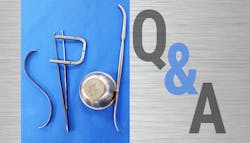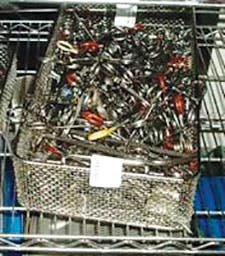Instrument modification hazardous; needle holder magnetization unrecognized; instrument cleaning technique vs. capacity
Submit your questions: email: [email protected]
Q
We have a surgeon who requested some modifications be made to a couple of his Weitlaner retractors. The modifications required removing a prong and shortening another. We found a local metal craftsman who was able to successfully do this.
Since doing this I have been getting requests to have modifications made to other instruments and needles. The craftsman does not provide any instructions for use (IFU) for the modified items. I am not sure this is something that we should continue to do. The surgical director has told me that the modifications are not major and that I should continue to do what the surgeons request. I have not been able to find any type of documentation to support my argument to discontinue the modification of instruments What say you?
A
I say NAY. The modification of any medical devices is a very dangerous practice and one that may place healthcare workers and patients in danger. When the modification to a surgical instrument, or any other medical device, is allowed by an organization, the organization assumes legal responsibilities. From a legal perspective, the party that performs or allows for the alterations of any medical device becomes the manufacturer of said device and must comply with the US Food and Drug Administration (FDA) Good Manufacturing Practice (GMP) regulations.
GMP are the practices required in order to conform to the guidelines recommended by the agencies that control the authorization and licensing of the manufacture and sale of food and beverages, cosmetics, pharmaceutical products, dietary supplements, and medical devices. These guidelines provide minimum requirements that a manufacturer must meet to assure that its products are consistently high in quality, from batch to batch, for their intended use. The rules that govern each industry may differ significantly; however, the main purpose of GMP is always to prevent harm from occurring to the end user. Additional tenets include ensuring that the end product is free from contamination, that it is consistent in its manufacture, that its manufacture has been well documented, that personnel are well trained, and that the product has been checked for quality more than just at the end phase. GMP are ensured through the effective use of a quality management system (QMS).
Abiding by the FDA GMP involves very complex processes requiring specialized manufacturing as well as scientific and QMS expertise, which is likely beyond the scope of your hospital or the metal craftsman you are utilizing to modify your instruments.
I would suggest that you share this information with your director and consult with your risk management and/or legal department on this matter. I would also strongly recommend that you discontinue this practice immediately and that you remove any devices that have been modified from circulation and further use. Going forward, if a surgeon has an idea for a new design of an instrument, he or she should work with an instrument manufacturer.
Q
I am a traveler nurse and currently work at a doctor-owned surgery center. I recently received a strange request from a surgeon who wanted his needle holders magnetized. I have never had such a request before. What is the standard for this?
A
That is a rather unusual request. I have heard of magnetic holders for needles and demagnetizing an instrument but not the reverse. I have contacted a few instrument manufacturers and instrument specialists, none of whom heard of magnetizing an instrument or offered a magnetic holder. Perhaps a reader of the column can provide further insight.
Q
A
I am not aware of any standard or recommendation that specifies the maximum number of instruments that can be placed in a washer basket. What’s more important is that instruments must all be placed in the basket in a manner that will allow all surfaces, crevices, and parts to be fully exposed to the water spray and mechanical action.About the Author

Ray Taurasi
Ray Taurasi is Principal, Healthcare CS Solutions. His healthcare career spans over five decades as an Administrator, Educator, Technologist and Consultant. He is a member of AORN, SGNA, AAMI and a past president of IAHCSMM. Taurasi has been a faculty member of numerous colleges teaching in the divisions of business administration, nursing, and health sciences. He is the author of numerous articles and textbook chapters; he is a frequent speaker at national and international healthcare conferences.
Note to readers from Ray Taurasi - In 2021, my life’s career path will transition to one of new opportunities and adventures. As a result, after nearly 19 years and 225 CS Solution columns, this edition will be my last.
“All changes, even the most longed for, have their melancholy; for what we leave behind us is a part of ourselves; we must die to one life before we can enter another.”– Anatole France
I wish you and your loved ones a healthy and joyful holiday season and a beautiful New Year! God Speed, Ray
https://www.facebook.com/pages/category/ Local-Business/Healthcare-CS-Solutions-128857 3061153887/ • email: [email protected]


